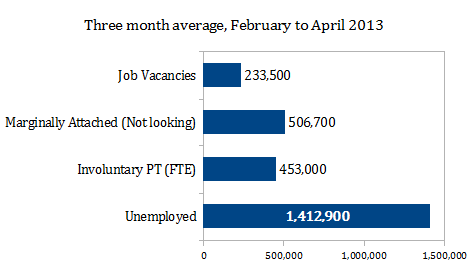
Upon being appointed Minister of the newly renamed “Employment and Social Development” (formerly HRSDC), Mr. Kenney tweeted his view on the Canadian labour market:
I will work hard to end the paradox of too many people without jobs in an economy that has too many jobs without people. #shuffle13
— Jason Kenney (@kenneyjason) July 15, 2013
Coincidentally, perhaps, the most recent Statistics Canada numbers on job vacancies came out this morning. Compared to a year ago, there were 20,000 fewer job vacancies in Canada this April, and only 1.6% of all jobs were unfilled at the end of the month. Even in booming Alberta the ratio of unfilled jobs to total labour demand fell from 3.5% last April to 2.5% this April.
Using the official measure of unemployment, there were 6.1 unemployed persons in Canada for every job vacancy. As Sam Boshra points out in a recent post, Statistics Canada’s official unemployment measure leaves a significant amount of un(der) employment uncounted. Digging into the data, he finds that even Statistics Canada’s popular R8 measure is not as comprehensive as the U.S. measure of labour underutilization, U6.
U6 counts all persons marginally attached to the labour force, not just those termed “discouraged workers”. Marginally attached workers would like a job, but aren’t looking. They may be busy with unpaid work, going back to school to improve their prospects, or unable to find a job that can accommodate an illness / disability.
Sam calculates a U6 equivalent for Canada in 2012 at 14.2%, nearly double the official unemployment rate of 7.2%. That indicates a great deal of softness in the current Canadian labour market.
In terms of too many jobs without people, there seems to be little evidence to support that view that there is any job shortage outside the “oil patch”. The Bank of Canada’s Business Outlook Survey for Summer 2013 finds that “labour shortages remain subdued”, and are currently below levels reported by businesses through most of 2011 and 2012 (see BOS Chart 6). A (forthcoming) review of real average wages by 140 occupations shows no obvious wage pressures, although Mathematicians, Statisticians, and Actuaries have done well over the last few years.
Even though there are unemployed people in other areas of the country, the vacant jobs in Alberta (many in retail, accommodation, and food services) don’t pay enough to entice workers to move, especially when you take the higher cost of living into account.
There, I’ve solved the paradox! (There isn’t one). I’ll be waiting for my thank-you letter from Minister Kenney.
Updated: The job vacancy numbers are released as a three month average, so the recent numbers are the average of February to April 2013. Not only were there 1.4 million unemployed persons on average between February and April 2013, there were an additional 960,000 persons not counted as unemployed who wanted work. That gives us a ratio of 10.2 un(der)employed persons per job vacancy. Note: I’ve converted involuntary part-time into the number of full-time equivalent positions to avoid over-counting.

Angella MacEwen is a senior economist at the Canadian Labour Congress and a Broadbent Fellow. This article originally appeared on the Progressive Economics Forum.
